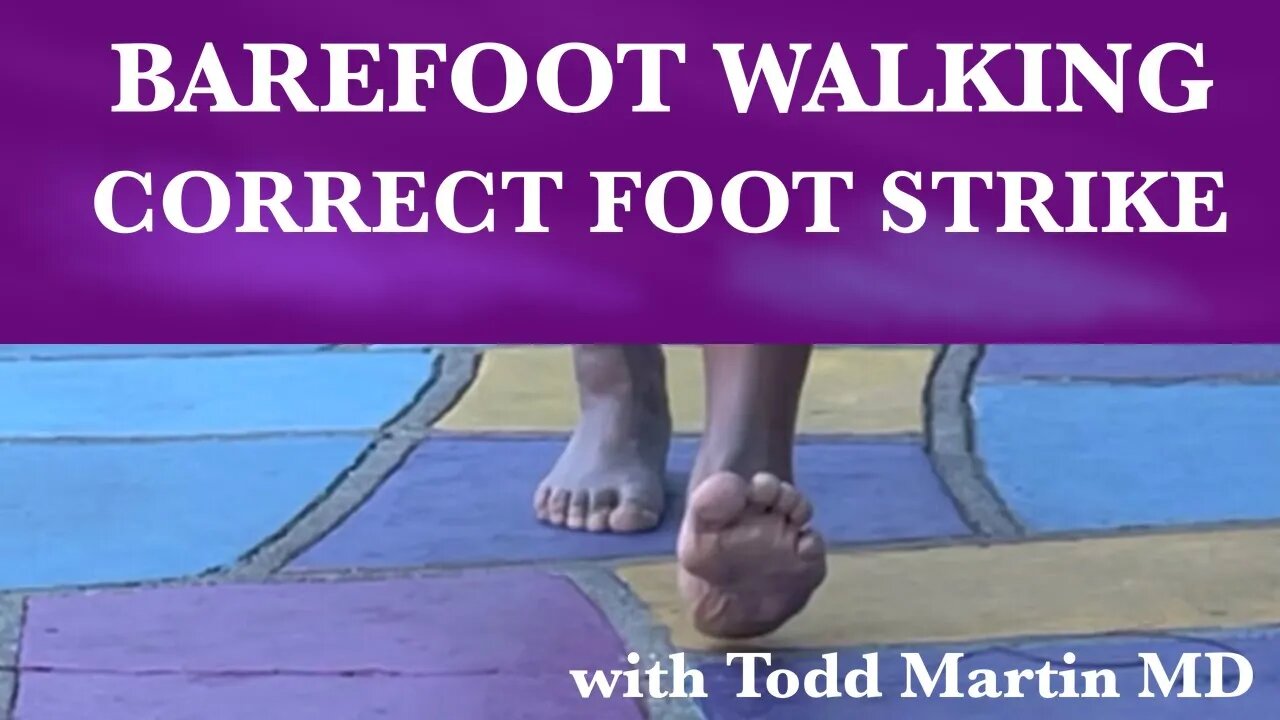Premium Only Content

Barefoot Walking-Correct Stride Length and Reduced Heel Impact
Barefoot Walking: Correct Stride Length and Reduced Heel Impact. Barefoot walking is gaining in popularity because it can produce a more natural walk with better connection to the ground. Transitioning effectively to barefoot or minimalist shoe walking requires walking with correct technique, stride length, and foot placement. Walking in heavily padded shoes can disguise many of the common problems people have with their walking technique. These problems become apparent quickly when we walk barefoot and can feel the impact of the heel on the ground. That doesn't mean heel strike is wrong. It means it needs to be done correctly. In this video I will explain how to do it correctly and show some of the common problems that lead to a heavy and painful heel strike.
AVOID:
Leaning forward
Anterior Pelvic Tilt
Over-Striding
DO This:
Vertical Posture
Neutral Pelvic Tilt
Place, Then Roll, Then Swing Through
Reduce Stride to the Optimal Length
When we walk correctly, the swing leg should reach a position hovering just above the ground before we bring the heel down. The motion to bring the heel down is a specific action of the core. There are some ways of walking which interfere with this proper function.
Leaning Forward: Leaning forward causes a heavy heel strike, not just because of the lean, but also because it is associated with pushing off with the glutes. Instead of pushing, we should be pulling from the front of the hips to generate the motion of the swing through. It should feel like gliding, not pushing.
Anterior Pelvic Tilt: Anterior pelvic tilt causes the heel to hit the ground without the opportunity to control the placement of the heel. This is a common posture issue that also affect walking. If you have an anterior pelvic tilt, you will notice an exaggerated arch in your lower back. You will also likely have difficulty transitioning to barefoot walking because it will be difficult to soften the heel placement. You will need to work on correcting the anterior pelvic tilt before you get too much into barefoot walking.
Over-Striding: Another common problem is overstriding. This can come from bringing the heel down and changing weight in the same movement. This causes the heel to hit hard and also lengthens the stride. To correct this , you need to focus on placing the heel first, then as a separate movement changing the weight. The body should flow smoothly from one movement to the next, but they should not occur as the same motion. The mantra I use to describe this is turn-tuck-lift. The turn is from the upper torso that places the heel. Then we tuck with the lower abs to change weight and bring the forefoot down. Then he use the hip muscles to swing through. Then we start over again with placement of the heel. It is important to get this sequence correct.
When you walk correctly, you should feet the weight over the heel-flat part of your foot before you begin to bring your heel down. If you notice your weight over the ball, you are probably over-striding.
00:00 Introduction
01:30 Gentle Heel Placement
02:28 Leaning Forward
03:38 Anterior Pelvic Tilt
05:17 Demonstration of Turn-Tuck-Lift
06:00 Over-Striding
07:19 Proper Weight Distribution
Visit my website: https://www.movementsphere.com/todd-martin-md
Get you copy of The Walking Code Ebook by clicking on the link below. This book can help you follow along with the videos and get a deeper understanding of the theoey of The Walking Code.
https://www.movementsphere.com/the-walking-code-book
Join this channel to get access to perks:
https://www.youtube.com/channel/UCAkwXF7adXLWvzaoxWydHhg/join
-
 1:19:40
1:19:40
JULIE GREEN MINISTRIES
2 hours agoLIVE WITH JULIE
32.1K102 -
 LIVE
LIVE
LFA TV
14 hours agoLFA TV ALL DAY STREAM - MONDAY 8/11/25
8,518 watching -
 LIVE
LIVE
Chicks On The Right
3 hours agoMTG fighting w/Levin, Pritzker humiliated by Welker, Mamdani squeals like a girl, and psychotic libs
1,887 watching -
 LIVE
LIVE
The Bubba Army
2 days agoAlligator Alcatraz Closed?! - Bubba the Love Sponge® Show | 8/11/25
4,898 watching -
 29:03
29:03
DeVory Darkins
15 hours ago $6.40 earnedDemocrat Governors painfully HUMILIATED Trump drops BRUTAL WARNING for DC officials
7.03K53 -
 14:44
14:44
Preston Stewart
18 hours ago $1.15 earnedTrump's Cartel Crackdown
5.08K6 -
 1:05:58
1:05:58
Sarah Westall
15 hours agoForces Creating Massive Instability Worldwide: US, Ukraine, China, Israel, Colonel Douglas Macgregor
15.3K31 -
 LIVE
LIVE
BEK TV
2 hours agoTrent Loos in the Morning - 8/11/2025
90 watching -
 3:45:16
3:45:16
Badlands Media
1 day agoThe Narrative Ep. 34: The World Eater
111K41 -
 29:39
29:39
Afshin Rattansi's Going Underground
23 hours agoProf. Jeffrey Sachs: Will The Trump-Putin Meeting End the Ukraine Proxy War and Avert Nuclear War?
24.8K89